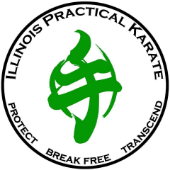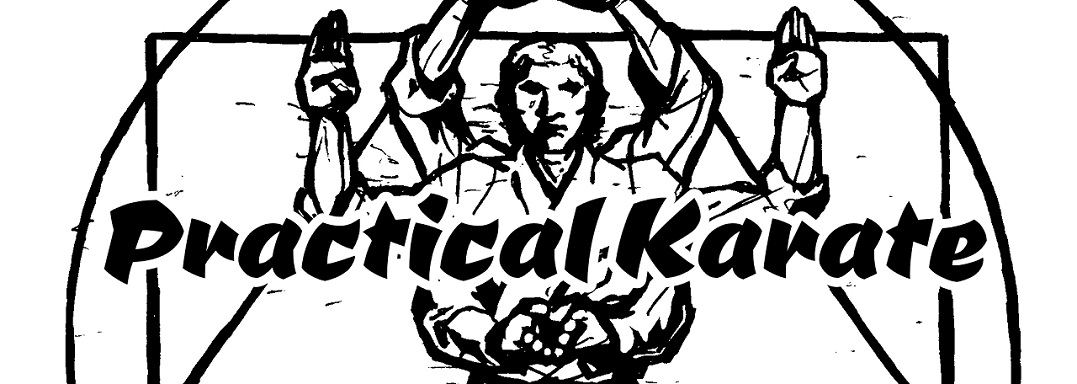-
Posts
2,803 -
Joined
-
Last visited
About Wastelander

- Birthday April 22
Personal Information
-
Martial Art(s)
Shorin-Ryu, Shuri-Ryu, Judo, KishimotoDi
-
Location
Salem, IL
-
Interests
Leatherwork, blacksmithing, writing, martial arts
-
Occupation
IT System Administrator
- Website
Recent Profile Visitors
The recent visitors block is disabled and is not being shown to other users.
Wastelander's Achievements

Black Belt (10/10)
-
I would agree that complicated self-defense techniques are generally a bad idea, but it's pretty rare that I come across anyone in the practical karate sphere who teaches self-defense techniques that I would consider complicated. Certainly nothing more complicated than you'd find in any other martial art or combat sport, and some pretty complex things can be pulled off, even in high level competitions, by people who have trained appropriately. I would also add that the existence of Kyokushin's knockdown sparring method actually runs counter to your argument about continuous full-power strikes. Yes, they can wear down an opponent over time, but I've seen MANY Kyokushin matches where the continuous shots to the body didn't amount to anything. Full-power strikes to vulnerable targets work, but you're going to get WAY more mileage out of striking the neck and head than you are the body. I know that this originally said "Don't live in America," rather than "bad areas," but the fact of the matter is that your location has very little to do with the types of attacks you are likely to have to deal with in a self-defense situation, because human violence tends to be gendered and age-determinate, but otherwise quite consistent. Chokeholds and bear hugs are common attacks against children and women, especially, so maybe YOU don't need to worry about it all that much, but plenty of people do. Plus, there is simply no guarantee that a statistical anomaly won't happen to you, and you get put in a chokehold or bear hug. You don't get to choose what the attacker does. Plus, the "if you don't live in bad areas" argument can be made about self-defense as a whole, as avoiding high risk areas lowers your risk in general, but doesn't have any impact on the TYPE of attack you're likely to face. Making this argument basically weakens your points about training for self-defense, because if you "don't live in bad areas," your chances of even needing to punch someone go down just as much as your chances of needing to grapple someone. I'm sorry to be the bearer of bad news, but this is very demonstrably false. A good punch only eliminates the need to be able to grapple if you drop the opponent with one shot before they get their hands on you. One-shot KOs against someone expecting violence (which someone attacking you will be) are rare, one-shot body KOs are even less likely, and self-defense situations don't always happen with you knowing where the attacker is and that they are going to attack you. Self-defense isn't a striking duel, like Kyokushin is. If someone attacks you, they don't have any reason to stand and bang, especially if they have any idea how to grapple someone, even without real training, and if you hit them hard, chances are they will not agree to your terms for the fight and let you keep hitting them. You wouldn't go into an MMA match as a pure striker and expect your opponent to have a kickboxing match with you, right? Same goes for self-defense. If both grappling and striking are possible, you NEED to be competent with both in order to be effective.
-
Your statement that "fist fighting was far more common than it is today" is most likely true, in a broad sense, but I don't agree with the proposal that this means karate is "supplementary training for 'the guy who can already fight.'" I'm not sure where you got that idea from, as I have only ever heard that from people who train in MMA and have little to no actual karate experience. I can't think of a single reputable instructor or historian of karate that has made such a claim, and if we are looking specifically at the history of Okinawa and the development of karate, this is simply not the case. The form of combat that the majority of Okinawan people had exposure to and training in was tegumi/muto, a folkstyle no-gi submission grappling sport, meaning that if karate were supplemental to anything, it would be the ability to grapple, largely on the ground. Untrained people certainly got into fist fights, but there was also a saying in Okinawa that went something along the lines of "if you see people fighting with closed fists, move along, but if they fight with open hands, watch and learn." Despite how it is presented in the modern day, karate is much less about punching than people realize. We must also bear in mind that karate was developed by nobility for three main purposes; self-defense, law enforcement, and security/bodyguard work. None of these contexts is really best served by learning how to fist fight, and the people involved in developing these arts were not the sort of men to get involved in fist fights, more often than not. COULD you use the sparring format you propose to teach students "the bare instinct of how to 'fight,' with more traditional karate techniques being taught along side it as...supplementary knowledge?" Honestly, I don't think so. What I DO think you would get out of it is the development of grit and the mindset of aggression, which are definitely beneficial for people who want to learn to fight, and I think that's really what you're getting at, but I think the skillset developed by the format is too limited to actually teach someone how to fight effectively. It also doesn't matter how many other techniques you teach if this is the only type of sparring you do, because if you never use the other techniques in sparring, you'll never develop the skill necessary to use them, so all you will ever use is body shots. I realize that I'm not telling you things that you want to hear, but I truly don't think you're going to get the benefits you're looking for out of the format you've proposed. There is no singular sparring method which is perfect for pressure testing karate, which is why my late Sensei and I employ a layered approach where we employ multiple different sparring formats to develop different skills and attributes, and to cover gaps left by the compromises and limitations of each format. I'm not saying that you shouldn't spar the way you've described, but it has some glaring flaws that need to be addressed by other forms of sparring. I also don't think removing protective gear is beneficial, at all. If you want extra conditioning, do body conditioning bareknuckle in controlled training exercises, as it is traditionally done. Wear protective gear for sparring, not just for insurance purposes, but because it increases the safety, health, and longevity of those involved without significantly reducing the effectiveness of the sparring.
-
First of all, welcome to the forum! You sure are coming out swinging with this subject! What you are proposing is essentially pre-Queensbury bareknuckle boxing, with the slight modification of not allowing punches to the head instead of it simply being uncommon due to the danger of injury. That's fine, but it's not karate. The way I see it, Shotokan and Kyokushin both significantly diminished the effective curriculum of karate by focusing almost exclusively on kicking and punching in their sparring, to begin with. You are then proposing to take one of those arts and strip it down even more so that it is just punching the body. At that point, you're just doing bareknuckle boxing. Everything that makes it karate is gone. You essentially admit that you understand this when you point out that it isn't a style of karate, and that it can be slapped onto any curriculum. I am in no way trying to offend you when I say this, but it sounds, to me, as if you DON'T actually want to train in or teach karate. Nothing in your post suggests, to me, that you actually value the art, as it is. You just value full-contact fighting, and you don't like how people are doing it. I'm afraid I will have to contradict your position on protective gear and the value of body-only sparring, as well. The fact of the matter is that protective gear allows for more consistent sparring without injury, at all levels of contact, whether you like it or not, and sparring without punches to the head develops very bad habits that will carry over into every form of fighting you try to do. As others have already mentioned, you will also have a hard time dealing with insurance as a full-contact school that uses no protective gear. I just don't see enough value in this methodology to outweigh the issues, and I certainly don't see why it should be attached to karate, at all.
-
Yes. My late Sensei made use of heavy bags, sometimes double-end bags, and plenty of strength and conditioning equipment. I don't currently have the ability to put up a hanging bag of any kind, but I do still make use of a lot of strength and conditioning equipment. I incorporate some degree of strength and conditioning at the beginning of my classes, just as my late Sensei did, but class time is mainly for actual martial arts training, so real dedicated S&C workouts are probably only once or twice a month. Students are expected to work on that on their own.
-
Depends on the severity and the cause, for me. If it's mild, I can generally use mint or ginger to calm my stomach. If that doesn't cut it, I take dramamine, and after that I can take Zofran or Fenergan, but those are prescriptions. If the nausea is caused by migraine, I have Ubrelvy to stop the migraine and reduce the symptoms, but that's also prescription.
-
I think you'll find that a lot of us tend to do kata when we are training by ourselves. It's a convenient training method for improving your skills while you're alone. If I have equipment, though, I'll generally go for drills that use the equipment, so it depends on what you have available.
-

Quitting at Black Belt
Wastelander replied to bushido_man96's topic in Instructors and School Owners
People are notoriously bad at goal-setting, and I think that this is an example of that, along with people getting bored or life just getting in the way. I would say that most people who start training in traditional martial arts set the goal of "earning black belt," and they don't tend to update their goals as they get closer to achieving that, so once they earn black belt, they feel as though they have "finished what they started." I hear this a lot from people who quit before earning black belt, as well, saying that they want to get back into it and "finish what they started." I think we, as instructors, need to be more clear about the fact that black belt is NOT being "finished" with your martial arts journey, and help them come up with goals to achieve after reaching black belt. -
I'm sorry for the loss to his family, friends, and organization.
-
Karate and kobudo historian, Andreas Quast, recently posted some footage of a kobudo tournament on Okinawa, and it reminded me of the general subject of sparring in kobudo: https://www.facebook.com/share/v/15EpmMsVYZ/ When I first learned kobudo, I was taught a non-contact version of kumite where you had to make contact with the opponent's weapon, first, and then you would launch a strike at the opponent's arms, legs, body, or head. If it got close enough, you scored a point, and reset, very similar to karate point fighting. Even back then, I liked the idea of actual contact sparring with weapons more, and I thought up all kinds of ways to make it safe to do so, eventually landing on almost the exact same thing you see in the video, although I never got the chance to do it. I'm curious if anyone has done this type of kobudo sparring, or any sort of sparring with weapons.
-

Battle Scars - Your worst Martial Arts injuries
Wastelander replied to KarateKen's topic in General Martial Arts Discussion
I have dislocated my right knee several times in martial arts training. The first time I dislocated it, I was just walking in a straight line down a hallway at school, which should have been a clue that I had something wrong with my joints, but I didn't get a diagnosis about that for about 15 years. The first time I dislocated it in martial arts training, I was working with a throwing dummy in my Judo class, and I was told to work on drop seoi-nage, which resulted in the dummy slamming into the side of my dropped knee. The second time, I was throwing slip kicks on a pad, and my foot slid on the sweaty mat. The third time was attempting a foot sweep at the wrong time when their leg was fully based. -
Well, I know that it's quite common to solicit students to leave reviews, but I don't think most martial arts schools are astroturfing. It definitely DOES happen, on occasion, though. One of the karate schools my late Sensei had trained at as a kid did it once Yelp became big. They also left completely false negative reviews of my late Sensei's dojo.
-
That's great news!
-

Rare Styles: KishimotoDi, UdunDi, To'on-Ryu, Kojo-Ryu, etc.
Wastelander replied to Wastelander's topic in Karate
You're more than welcome to do so, but here is the draft ruleset so you can have the full outline. Competition Kakedameshi Draft Rules.pdf -
Thanks! Points of contact are huge when you're at close range, so it makes perfect sense that you'd have experienced that in BJJ. I know I did in Judo. The lack of respect for the strikes in my example videos is mainly because we were going light, and keeping it playful. When you ramp up the intensity, and start making a bit of impact to the face, it changes the dynamic, for sure.
-

Rare Styles: KishimotoDi, UdunDi, To'on-Ryu, Kojo-Ryu, etc.
Wastelander replied to Wastelander's topic in Karate
Turning it into a competitive format is certainly the challenge, because it's easy to do when no one is keeping score, but if you want it to be a competition, you have to set up scoring criteria and there have to be people trained to be judges and referees. I actually suspect that, even if it took off as a competition format, it would not draw many spectators--it's too close range to see what's going on from the stands, so unless there are knockouts allowed it's unlikely that many people will want to watch it. Just as Judo and BJJ are primarily watched by people who practice those arts and their families, I think kakedameshi would be similarly watched only by karateka and their families. If it's done right, though, it could certainly become a feeder for MMA competition. For what it's worth, I have actually taught a couple seminars on kakedameshi, and even sell the recorded video from one of them on my website. I've also tried to get focus groups put together from karateka around the world to test out competition rulesets, but they have proven to be inconsistent and eventually fall off the map. For gear, I use MMA-style gloves, mouthguard, and groin protector, with shin guards and headgear being optional. At such a close range, head kicks are unlikely, and we know that headgear is more likely to increase your risk of TBI, so shin guard and headgear don't really need to be used, IMO. As for the points system, it gets a bit complicated, since there are so many things you can do in kakedameshi. If we made it so you could win by KO, most people would never participate, because it's just too dangerous, so while we could have a full-contact circuit where that's allowed, it probably won't attract many competitors. Semi-contact and light-contact divisions would probably be more popular. We also have to consider the fact that instant-win conditions (such as KO, submission, or ring-out) and higher point values will attract more focus from competitors, causing them to emphasize those aspects more than others. If we want kakedameshi to actually pressure test and represent karate, then that needs to be taken into account. As a quick overview, I've proposed 5 minute matches, with the winner being the person with the most points by the end of the time, and a 1 minute sudden-death round if there is a draw. You can also win if your opponent taps out. There are penalties for breaking away from your opponent, because you have to maintain at least 1 point of contact with them at all times, as well as for stalling. Disqualification occurs after 5 penalties, or if you injure your opponent (including KOs outside of full-contact divisions). Points are awarded for achieving dominant positions, landing strikes, successfully manipulating the opponent with joint locks, and successfully knocking the opponent to the ground. You can also earn points for keeping your opponent on the ground, as long as you are in a dominant position, and you can earn points by getting back to your feet when your opponent is trying to keep you down. 1 Point - Strikes to the limbs and body, immobilizing the opponent's arms, disrupting the opponent's posture with a lock/sweep/attack to "vulnerable points," and successfully preventing a downed opponent from standing back up 2 Points - Strikes to the head, successfully defending a throw or leg-reaping takedown, successful takedown where both participants fall, holding an opponent in a lock or stranglehold for 10+ seconds, and regaining top position on the ground 3 points - Successful takedown where tori remains standing, successfully regaining the feet while the opponent is attempting to keep the fight on the ground, successful takedown from the ground against a standing opponent which results in tori getting back to their feet or taking top position on the ground, and pushing your opponent out of the ring. These are still in the workshopping phase, of course, and I actually have a more detailed write-up I've used for people testing it out. My hope with the scoring is that it will emphasize trying to keep yourself off the ground and engaged in the fight standing up, and from the little feedback I've gotten so far, that seems to work. The biggest issue is preparing judges and referees, because they have to keep a close watch on what's happening and try to keep score (a click counter is best for that). Since that basic premise comes from Chinese pushing hands competitions, that makes perfect sense. I actually include a provision for that in my ruleset, although it isn't an instant-win to push your opponent out of the ring.




